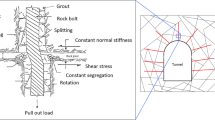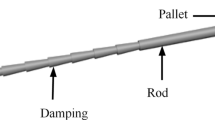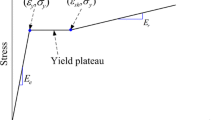Abstract
In this paper, a unified rock bolt model is proposed and incorporated into the two-dimensional discontinuous deformation analysis. In the model, the bolt shank is discretized into a finite number of (modified) Euler–Bernoulli beam elements with the degrees of freedom represented at the end nodes, while the face plate is treated as solid blocks. The rock mass and the bolt shank deform independently, but interact with each other through a few anchored points. The interactions between the rock mass and the face plate are handled via general contact algorithm. Different types of rock bolts (e.g., Expansion Shell, fully grouted rebar, Split Set, cone bolt, Roofex, Garford and D-bolt) can be realized by specifying the corresponding constitutive model for the tangential behavior of the anchored points. Four failure modes, namely tensile failure and shear failure of the bolt shank, debonding along the bolt/rock interface and loss of the face plate, are available in the analysis procedure. The performance of a typical conventional rock bolt (fully grouted rebar) and a typical energy-absorbing rock bolt (D-bolt) under the scenarios of suspending loosened blocks and rock dilation is investigated using the proposed model. The reliability of the proposed model is verified by comparing the simulation results with theoretical predictions and experimental observations. The proposed model could be used to reveal the mechanism of each type of rock bolt in realistic scenarios and to provide a numerical way for presenting the detailed profile about the behavior of bolts, in particular at intermediate loading stages.
















Similar content being viewed by others
References
An XM, Ma GW, Cai YC, Zhu HH (2011) A new way to treat material discontinuities in the numerical manifold method. Comput Meth Appl Mech Eng 200(47–48):3296–3308. doi:10.1016/j.cma.2011.08.004
Bao HR, Zhao ZY (2012) The vertex-to-vertex contact analysis in the two-dimensional discontinuous deformation analysis. Adv Eng Softw 45(1):1–10. doi:10.1016/j.advengsoft.2011.09.010
Bao HR, Zhao ZY (2013) Modeling brittle fracture with the nodal-based discontinuous deformation analysis. Int J Comput Methods. doi:10.1142/S0219876213500400
Bao HR, Hatzor Yossef H, Huang X (2012) A new viscous boundary condition in the two-dimensional discontinuous deformation analysis method for wave propagation problems. Rock Mech Rock Eng 45(5):919–928. doi:10.1007/s00603-012-0245-y
Cai Y, Esaki T, Jiang YJ (2004) An analytical model to predict axial load in grouted rock bolt for soft rock tunnelling. Tunn Undergr Space Technol 19(6):607–618. doi:10.1016/j.tust.2004.02.129
Chang CT (1995) Nonlinear dynamic discontinuous deformation analysis with finite element meshed block system. Ph.D. Thesis. University of California, Berkeley
Charette F, Plouffe M (2007) Roofex: results of laboratory testing of a new concept of yieldable tendon. In: Potvin Y (eds) Deep mining 07, proceeding of the 4th international seminar on deep and high stress mining. Australian Centre for Geomechanics, Perth, pp 395–404
Chen Y (2014) Experimental study and stress analysis of rock bolt anchorage performance. J Rock Mech Geotech Eng 6(5):428–437. doi:10.1016/j.jrmge.2014.06.002
Chen Y, Li CC (2015a) Performance of fully encapsulated rebar bolts and D-Bolts under combined pull-and-shear loading. Tunn Undergr Space Technol 45:99–106. doi:10.1016/j.tust.2014.09.008
Chen Y, Li CC (2015b) Influences of loading condition and rock strength to the performance of rock bolts. Geotech Test J 38(2):208–218. doi:10.1520/GTJ20140033
Cho N, Martin CD, Sego DC, Christiansson R (2004) Modelling dilation in brittle rocks. In: Proceeding of the 6th North America rock mechanics symposium (NARMS), Houston, Texas, USA
Gu J, Zhao ZY (2009) Considerations of the discontinuous deformation analysis on wave propagation problems. Int J Numer Anal Meth Geomech 33(12):1449–1465. doi:10.1002/nag.772
Hatzor YH, Wainshtein I, Mazor DB (2010) Stability of shallow karstic caverns in blocky rock masses. Int J Rock Mech Min Sci 47(8):1289–1303. doi:10.1016/j.ijrmms.2010.09.014
He L, Ma GW (2010) Development of 3D numerical manifold method. Int J Comput Methods 7(1):107–129. doi:10.1142/S0219876210002088
He L, An XM, Zhao ZY (2015) Fully grouted rock bolts: an analytical investigation. Rock Mech Rock Eng 48(3):1181–1196. doi:10.1007/s00603-014-0610-0
Hsiung SM (2001) Discontinuous deformation analysis (DDA) with nth order polynomial displacement functions. In: Proceedings of the 38th US rock mechanics symposium, Washington DC, pp 1437–1444
Huang ZP, Broch E, Lu M (2002) Cavern roof stability-mechanism of arching and stabilization by rockbolting. Tunn Undergr Space Technol 17(3):249–261. doi:10.1016/S0886-7798(02)00010-X
Industrial Fasteners Institute (2003) Inch fastener standards—7th edition
Itasca (2004) UDEC-universal distinct element code, version 4.0. Itasca Consulting Group, Minneapolis
Itasca (2007) 3DEC-3-dimensional Distinct Element Code, Version 4.1. Itasca Consulting Group, Minneapolis
Ivanović A, Neilson RD (2009) Modelling of debonding along the fixed anchor length. Int J Rock Mech Min Sci 46(4):699–707. doi:10.1016/j.ijrmms.2008.09.008
Jager AJ (1992) Two new support units for the control of rockburst damage. In: Proceedings of the international symposium on rock support, Sudbury, Ontario, Canada, 16–19 June, pp 621–631
Jalalifar H (2006) A new approach in determining the load transfer mechanism in fully grouted bolts. Ph.D. Thesis. University of Wollongong
Jalalifar and Naj (2010) Experimental and 3D numerical simulation of reinforced shear joints. Rock Mech Rock Eng 43(1):95–103. doi:10.1007/s00603-009-0031-7
Jiao YY, Zhang XL, Zhao J, Liu QS (2007) Viscous boundary of DDA for modeling stress wave propagation in jointed rock. Int J Rock Mech Min Sci 44(7):1070–1076. doi:10.1016/j.ijrmms.2007.03.001
Jing LR, Ma Y, Fang ZL (2001) Modeling of fluid flow and solid deformation of fractured rocks with discontinuous deformation analysis (DDA) method. Int J Rock Mech Min Sci 38(3):343–355. doi:10.1016/S1365-1609(01)00005-3
Kim YI, Amadei B, Pan E (1999) Modeling the effect of water, excavation sequence and rock reinforcement with discontinuous deformation analysis. Int J Rock Mech Min Sci 36(7):949–970. doi:10.1016/S0148-9062(99)00046-7
Koo CY, Chern JC (1996) The development of DDA with third order displacement function. In: Proceedings of the first international forum on discontinuous deformation analysis (DDA) and simulations of discontinuous media, TSI Press, San Antonio, Texas, pp 342–349
Koyama T, Nishiyama S, Yang M, Ohnishi Y (2011) Modeling the interaction between fluid flow and particle movement with discontinuous deformation analysis (DDA) method. Int J Numer Anal Methods Geomech 35(1):1–20. doi:10.1002/nag.890
Li CC (2010) A new energy-absorbing bolt for rock support in high stress rock masses. Int J Rock Mech Min Sci 47(3):396–404. doi:10.1016/j.ijrmms.2010.01.005
Li CC (2011) Chapter 18. Rock support for underground excavations subjected to dynamic loads and failure. In: Zhou Y, Zhao J (eds) Advances in rock dynamics and applications. CRC Press, Boca Rotan, pp 483–506
Li CC, Doucet C (2012) Performance of D-bolts under dynamic loading. Rock Mech Rock Eng 45(2):193–204. doi:10.1007/s00603-011-0202-1
Li C, Håkansson U (1999) Performance of the Swellex bolt in hard and soft rocks. In: Proceedings of the international conference on rock support and reinforcement practice in mining, Balkema, pp 103–108
Li C, Stillborg B (1999) Analytical models for rock bolts. Int J Rock Mech Min Sci 36(8):1013–1029. doi:10.1016/S1365-1609(99)00064-7
Lin CT, Amadei B, Jung J, Dwyer J (1996) Extensions of discontinuous deformation analysis for jointed rock masses. Int J Rock Mech Min Sci 33(7):671–694. doi:10.1016/0148-9062(96)00016-2
Ma GW, An XM, Zhang HH, Li LX (2009) Modeling complex crack problems using the numerical manifold method. Int J Fract 156(1):21–35. doi:10.1007/s10704-009-9342-7
Maclaughlin M, Sitar N, Doolin D, Abbot T (2001) Investigation of slope-stability kinematics using discontinuous deformation analysis. Int J Rock Mech Min Sci 38(5):753–762. doi:10.1016/S1365-1609(01)00038-7
Moosavi M, Grayeli R (2006) A model for cable bolt-rock mass interaction: integration with discontinuous deformation analysis (DDA) algorithm. Int J Rock Mech Min Sci 43(4):661–670. doi:10.1016/j.ijrmms.2005.11.002
Nie W, Zhao ZY, Ning YJ, Sun P (2014) Development of rock bolt elements in two-dimensional discontinuous deformation analysis. Rock Mech Rock Eng 47(6):2157–2170. doi:10.1007/s00603-013-0525-1
Shi GH (1988) Discontinuous deformation analysis—a new numerical model for the static and dynamics of block systems. Ph.D. Thesis. University of California, Berkeley
Shi GH (1992). Manifold method of material analysis. In: Transactions of the conference on applied mathematics and computing, Minneapolis: Minnesota. pp 57–76
Shyu K (1993) Nodal-based discontinuous deformation analysis. Ph.D. Thesis. University of California, Berkeley
Spang K, Egger P (1990) Action of fully-grouted bolts in jointed rock and factors of influence. Rock Mech Rock Eng 23(3):201–229. doi:10.1007/BF01022954
Varden R, Lachenicht R, Player J, Thompson A, Villaescusa E (2008) Development and implementation of the Garford Dynamic Bolt at the Kanowna Belle Mine. In: 10th Underground operators’ conference, Launceston, Australia, p 19
Wang MC (2003) Finite element method. Tsinghua University Press, Beijing (In Chinese)
Windsor CR (1997) Rock reinforcement systems. Int J Rock Mech Min Sci 34(6):919–951. doi:10.1016/S1365-1609(97)80004-4
Wu JH (2010) Seismic landslide simulations in discontinuous deformation analysis. Comput Geotech 37(5):594–601. doi:10.1016/j.compgeo.2010.03.007
Wu JH, Ohnishi Y, Nishiyama S (2004) Simulation of the mechanical behavior of inclined jointed rock masses during tunnel construction using discontinuous deformation analysis (DDA). Int J Rock Mech Min Sci 41(5):731–743. doi:10.1016/j.ijrmms.2004.01.010
Wu JH, Ohnishi Y, Nishiyama S (2005) A development of the discontinuous deformation analysis for rock fall analysis. Int J Numer Anal Methods Geomech 29(10):971–988. doi:10.1002/nag.429
Yazici S, Kaiser P (1992) Bond strength of grouted cable bolts. Int J Rock Mech Min Sci 29(3):279–292. doi:10.1016/0148-9062(92)93661-3
Yeung MR, Jiang QH, Sun N (2003) Validation of block theory and three-dimensional discontinuous deformation analysis as wedge stability analysis methods. Int J Rock Mech Min Sci 40(2):265–275. doi:10.1016/S1365-1609(02)00137-5
Zhao ZY, Zhang Y, Bao HR (2011) Tunnel blasting simulations by the discontinuous deformation analysis. Int J Comput Methods 8(2):277–292. doi:10.1142/S0219876211002599
Acknowledgements
This study is supported partially by supported by “the Fundamental Research Funds for the Central Universities, China,” and the National Natural Science Foundation of China (Grant Nos. 11402070, 41372266). These supports are gratefully acknowledged.
Author information
Authors and Affiliations
Corresponding author
Rights and permissions
About this article
Cite this article
He, L., An, X.M., Zhao, X.B. et al. Development of a Unified Rock Bolt Model in Discontinuous Deformation Analysis. Rock Mech Rock Eng 51, 827–847 (2018). https://doi.org/10.1007/s00603-017-1341-9
Received:
Accepted:
Published:
Issue Date:
DOI: https://doi.org/10.1007/s00603-017-1341-9




